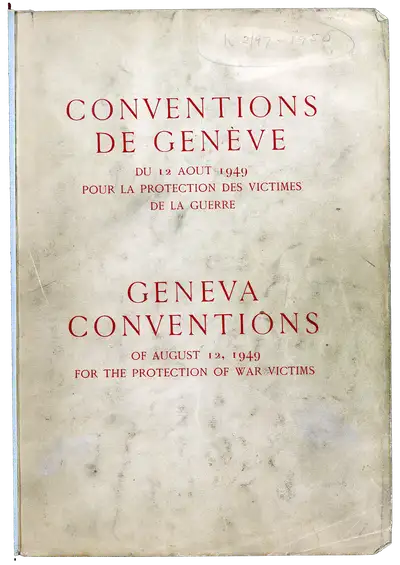Record revealed
The Geneva Convention, 1949
The Second World War showed the need to build on and codify the laws of war around the treatment of prisoners of war, those in medical need, and – especially – civilians. This document sets out the rules that its signatory nations agreed to follow in wartime.
Images
Image 1 of 2

Cover of the Geneva Convention, 1949
Transcript
Conventions de Genève
Du 12 Aout 1949
Pour la protection des victimes
De la guerre
Geneva Conventions
Of August 12, 1949
For the protection of war victims
Image 2 of 2

First page of Part I of the Geneva Convention, 1949
Partial transcript
The undersigned Plenipotentiaries of the Governments represented at the Diplomatic Conference held at Geneva from April 21 to August 12, 1949, for the purpose of establishing a Convention for the Protection of Civilian Persons in Time of War, have agreed as follows:
Part I
General provisions
Article I
The high Contracting Parties undertake to respect and to ensure respect for the present Convention in all circumstances.
Article 2
In addition to the provisions which shall be implemented in peacetime, the present Convention shall apply to all cases of declared war or of any other armed conflict which may arise between two or more of the High Contracting Parties, even if the state of war is not recognized by one of them.
The Convention shall also apply to all cases of partial or total occupation of the territory of a High Contracting Party, even if the said occupation meets with no armed resistance...
Why this record matters
- Date
- 12 August 1949
- Catalogue reference
- FO 93/1/401
Though many laws governing the treatment of prisoners of war (POWs) had been signed before the Second World War, they had largely dealt with combatants and their treatment, rather than protecting civilians during wartime. The Fourth Geneva Convention, signed in 1949, sought to rectify that.
The previous Geneva Convention from 1929, on which this one was based, ensured that POWs and those injured in conflict were treated in a certain way. They would have access to minimum levels of medical care, accommodation, and food provided by captors. POWs would also be permitted to take part in recreational activities and carry out labour in work not relating to the war effort, and which was not dangerous. POW camps were to be inspected by a ‘protecting power’, and the International Red Cross was to ensure that these rules were being followed. All these elements remained in the 1949 version.
Taking in the experiences of the Second World War, the 1949 Convention added provision to protect civilian populations against certain consequences of war. Though often referred to as a single convention, it actually consists of four separate ones that were all signed on the same day, entitled:
- The Geneva Convention for the Amelioration of the Condition of the Wounded and Sick in Armed Forces in the Field
- The Geneva Convention for the Amelioration of the Condition of Wounded, Sick and Shipwrecked Members of Armed Forces at Sea
- The Geneva Convention Relative to the Treatment of Prisoners of War
- The Geneva Convention Relative to the Protection of Civilian Persons in Time of War.
The last of these, dealing with the treatment of civilians, included providing neutral zones and allowing for the evacuation of the sick and wounded. It stated that this should be applied ‘without any adverse distinction based, in particular, on race, nationality, religion or political opinion’, with intent to ‘alleviate the sufferings caused by war’.
Part III of the Convention, which formed the largest part of the document, governed the status and treatment of 'protected persons', a legal term including both POWs and civilians. It also applied to civilians of enemy nationality – people living in the country of a hostile state. After the large-scale internment of civilians during the Second World War, when little formal protection existed for so-called ‘enemy aliens’, this change ensured that they had protections in law too.
The Convention was accepted and signed by 196 countries and came into effect in 1949. This record is the ratified copy held by the British Government. It is kept in our collections, alongside many other treaties and international agreements signed by the UK.
